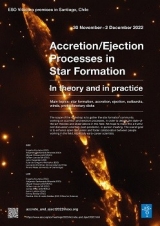Accretion/Ejection Processes in Star Formation: In Theory and in Practice
November 30 - December 2, 2022
Registration is Free to all participants
The rationale behind the meeting is to exchange recent results on accretion-ejection in young stars, from low to high mass and from early to more evolved stages. We hope to make this a fruitful and discussion-oriented, post-pandemic, in-person meeting. The aim is to establish a platform for students and early-career scientists in the field in addition to a limited number of invited overview talks.
This is a 3 day in person workshop that will take place at ESO/Vitacura premises in Santiago, Chile and is aimed to host up to 30 on-site participants. Given the limited amount of participants we recommend not to book flights or accommodation until the SOC confirm your contribution (by 1st of October). For information, questions please contact accrete_and_eject2022(at)eso.org.
Please note that organizers will provide coffee breaks, lunches, and a cocktail on Wednesday evening. We also plan an optional dinner on Friday in a restaurant close to the venue, in which everyone who wishes to attend will cover their own expenses.
Rationale
The accretion and ejection of material are the two dominant processes driving star formation and protoplanetary disk evolution. Accretion via circumstellar discs has a significant footprint on both protostellar evolution and the pre-main-sequence phase, while the specific accretion rates set boundaries on the resulting stellar masses as well as the lifespan of protoplanetary discs. On the other hand, the ejection of matter, in the form of outflows, winds and jets, is a ubiquitous phenomenon towards young accreting stars of ranging masses and evolutionary stages. Indeed, jets/winds can remove excess angular momentum and have a strong influence on the final mass a star can reach, and on the immediate environment where planets form (i.e, the protoplanetary disks).
However, neither of these processes is yet well-understood, as we still have scarce evidence on the origin of the tracers we use to monitor these phenomena, and we lack significant knowledge of the accretion/ejection interface and physical connection. In this workshop, we propose to gather the Chilean-based star formation community working in this field, in order to debate the state-of-the-art theories and observations targeting the accretion/ejection processes in star formation. We wish to have ample time for discussion and interaction between the participants, thus aiding the interchange of knowledge on the different observational and numerical techniques and wavelength coverages for a range of stellar masses (low to high) and evolutionary stages (embedded to PMS).
The goal of the workshop is thus to enhance open discussion and foster collaborations between people working in the field. Being held at the ESO/Vitacura campus, we will also take advantage of the local knowledge in instrumentation and observational techniques (ALMA, VLT(I)). To stimulate discussion and to attain a higher degree of understanding of those very enigmatic phenomena, we will have a combination of referent speakers and lecturers, who will provide insights on the technical as well as the scientific background (lectures ranging from simulations to observing techniques), while highlighting the latest advances in the field (i.e, review talks). In addition, there will be time slots for the participants to present their current research and line of thought, while dedicated discussion sessions will focus on pinpointing open questions on the field and possible ways forward. We would like to dedicate one day to numerical models, and two other days to observational results, with a special focus on high-resolution techniques.

